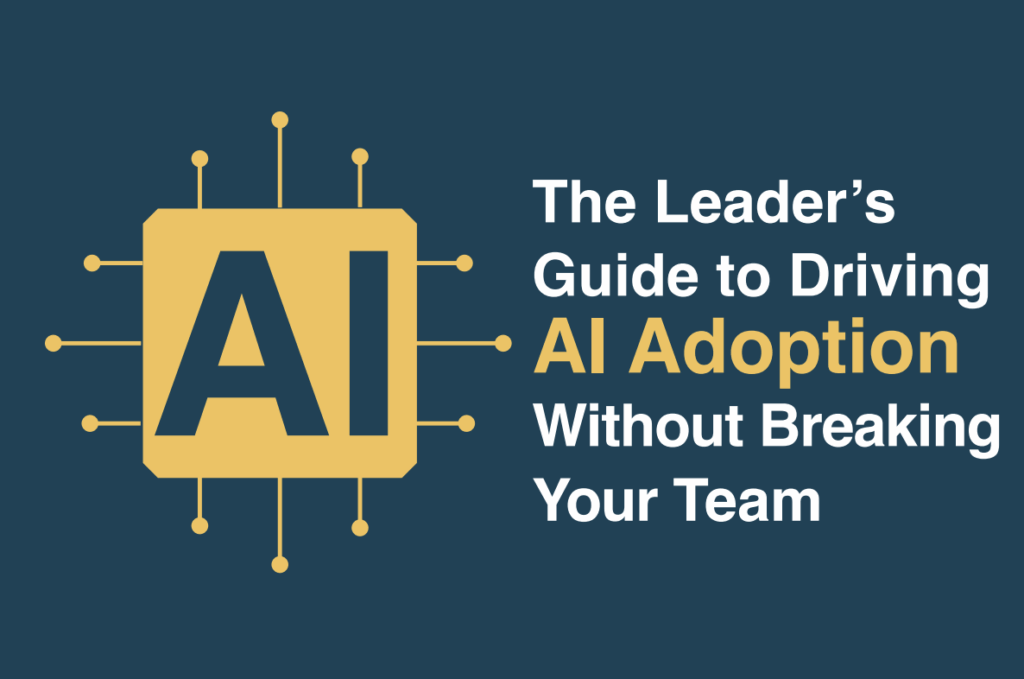The Leader’s Guide to Driving AI Adoption Without Breaking Your Team
By Propeller Chief Artificial Intelligence Officer, Todd Rebner.
It feels like everybody’s spinning up an AI company right now. VC firms like Sequoia and A16Z are dumping billions into AI investments, and everybody wants a piece of it. The Gartner Hype Cycle is playing out right before our eyes, pushing us toward the Peak of Inflated Expectations. I predict it’s only a matter of time until we see AI for bagels.
Not to burst the vaporware bubble, but expectations for AI aren’t yet lining up with reality. McKinsey reports that while 8 in 10 companies are using generative AI, 80% aren’t seeing tangible impact yet. Meanwhile, a recent LinkedIn survey reveals that more than half of professionals say learning AI feels like another job, and 40% say the pace of change is affecting their wellbeing.
If you’re a startup leader trying to navigate AI adoption with a team that’s feeling overwhelmed, you’re facing what might be the biggest management challenge of your career. The good news? Effective change management principles can guide you through this transformation, so long as you’re willing to build the plane while flying it. Here are some essential tips to get you going.
Don’t Sleep on Change Management
Here’s the uncomfortable truth from someone who’s seen it firsthand: 80% of all failed projects failed because they didn’t recognize change management as a necessary component. It was never bad requirements; those can always be fixed. You can always do new iterations, new versions, new deployments, rollbacks. In other words, when failure happens, it usually isn’t technical: it’s human.
We don’t value people’s input throughout the project’s lifecycle. We skip the ground-level conversations about fear and career uncertainty. We treat change management as an afterthought, rather than recognizing it as a distinct discipline requiring dedicated focus.
Consider this cautionary tale: I saw a major pharmaceutical company attempt a $100 million system implementation where the user adoption was so terrible, they had to go back to Excel pivot tables for like six months. Finally they were forced to bring in PwC for a whole change management stakeholder analysis to move things forward. The lesson? It’s better (and way less expensive) to pay attention to change management upfront than to think you’ll save time by putting it in the parking lot until the end. By then, it’s too late.
Acknowledge the Human Side of AI
Now that we’ve established the importance of humans in implementing technological change inside your company, let’s agree on a basic truth: AI is never going to replace human interaction.
In fact, as technology becomes more ubiquitous, human relationships will become that much more valuable. Startup leaders need to understand this isn’t just one of AI’s fundamental limitations, it’s the key to unlocking AI implementation that’s actually valuable and not just hype.
I don’t see a lot of people right now trusting AI with their bank accounts, and there’s good reason for that. AI systems are still imperfect. They hallucinate (they’ll say something with absolute 100% confidence that is totally wrong) and they lack relational context (even the most thorough prompt will have trouble capturing the nuances of interoffice politics). More fundamentally, nobody likes to take orders from a machine.
This means your AI strategy should focus on improving and augmenting the work humans are already doing, not replacing it. You want to frame adoption conversations around empowerment and productivity: helping people get more done in less time and maybe even take an actual lunch. If you want to make AI valuable right now and in the future, you’ll need to build realistic expectations for both your current workforce and AI’s limitations.
Start with Your Change Champions
Recognizing the importance of your people in your AI strategy, let’s look at what kinds of people are going to be most helpful in speeding you along. Every organization has potential AI champions hiding in plain sight; here are the traits to look for.
The hand-raisers: These are the people who volunteer for new projects, hunger for novelty or growth, and aren’t afraid to do something they’ve never done before. Some of them might be about to leave your company because you haven’t given them a chance to grow into a more exciting role, and this is how you’ll hold onto them.
The question-askers: There’s always that one guy who asks 100 questions in the meeting, and he gets to be in the room because he’s asking challenging questions. At first you might think of the question-askers as skeptics or cynics. But the fact that they’re asking questions means you can harness their curiosity.
The experimenters: These employees are comfortable with imperfection and experimentation, and understand that you’re not necessarily going to get it right the first time. It’s likely they’ve already started playing around with LLMs and are in a position to teach you and your company what they’ve learned.
The intellectually agile: These folks demonstrate that they can figure things out quickly and have a willingness to adapt to new tools and processes. They’re likely to thrive on a juicy challenge and will overlap with the hand-raisers and experimenters.
Avoid perfectionists: Perfectionists will struggle in a “move fast and break things” environment. Their need to get things exactly right (impossible in the rapidly evolving and uncertain territory of AI) will prevent them from operating at the speed AI demands.
Empower the CFO with a Strategic Role
For startups that haven’t yet recruited permanent executives in key leadership roles, the CFO often becomes the “voice of reason” and the “adult in the room.” This makes CFOs uniquely positioned to lead AI initiatives, because they have an extremely broad and deep perspective on the business. They’re expected to “see around corners” and offer insights and guidance. And they own the backbone of data that runs the company and helps predict its future success.
Lest you think of CFOs as risk-averse naysayers, Research from Salesforce found that CFOs have recently “shifted from being cautious spenders to ‘strategic investors who are betting on AI not just for cost-cutting, but as a crucial engine for long-term revenue growth.’” This quality—combined with their built-in concerns about AI’s security, privacy, and reputational risks—makes them exactly the kind of person you want to lead this critical project.
When startups empower a CFO to own their AI adoption, they’re assigning a role and responsibility to someone whose team is already familiar with systematizing business functions. This gives your company an opportunity to develop the products and processes that will systematize your AI adoption, so it doesn’t turn into a sandbox of random insecure LLM installations.
Balance Speed vs. Value
We’re operating in an environment where “speed is the new moat” and decades of change are now happening in the course of weeks. But time to market isn’t the same as time to value.
When a recent MIT study found that 95% of generative AI projects reported zero ROI, many companies took it as a sign to reevaluate whether their investments were focused on measurable outcomes rather than quick launches. If you treat your AI adoption strategy like a quantitatively driven initiative, with milestones and toll gates and measurable problems solved, you’re more likely to be pleased with the results.
Cut through the hype bubble by establishing value-creation metrics upfront: for example, cost savings, productivity gains, and time-to-value improvements.
Build While Flying with a Leadership Mindset
Perhaps the most important insight for startup leaders is to accept the paradox of our moment. AI development is moving at astronomical speed, yet we need to move thoughtfully to bring our people along.
The companies that will succeed are those led by people who can say, “I am a tremendously flawed human being and I do not know many things,” while also providing clear direction and support. This requires what one might call “productive, strategic urgency“—moving quickly while remaining deeply human in your approach.
Adopt a Change Management Framework
Finally, here’s a lightweight set of tenets to carry in your back pocket as you usher your team through this immense change.
- Acknowledge change management as a core discipline
Stop treating change management as something that happens in the background. It’s a specialized field with proven methodologies that requires intentional focus and resources from day one.
- Lead with listening and empathy
Good management requires listening skills to empower employees. Create space for honest conversations about career anxiety and other concerns. When someone says they’re worried AI will make them obsolete, don’t dismiss it: acknowledge that you’re worried, too.
- Educate with stories and real examples
People connect with concrete narratives more than abstract concepts. Share stories of both successful AI implementations and spectacular failures. Help your team understand what good change management looks like in practice.
- Paint an aspirational vision while acknowledging uncertainty
Get people excited by framing the change as a challenge: “We are going to work as hard as we possibly can to be as successful as we can, without treating people transactionally.” Acknowledge that you don’t know what you don’t know while focusing on the opportunities to make yourselves and your company smarter and stronger.
- Stress intellectual agility over perfect planning
Not everybody is going to fit in certain roles in this new era of working: your employees will need to be okay with figuring things out, fast, and some won’t be okay with that. Help your team develop comfort with rapid learning and adaptation rather than expecting complete certainty.
- Communicate early, often, and honestly
Change will happen whether you want it to or not, so you might as well communicate it proactively. People handle bad news better than no news. Create channels for sharing and feedback, early and often, because transparency builds trust.
Start Building
The most successful AI transformations will solve for both technological and human change simultaneously. They’ll recognize that while we may not know exactly what the future holds, we can create frameworks for navigating uncertainty together. Because ultimately while AI is artificial, the intelligence behind successful adoption is entirely human.
If you’re anything like Propeller, your company is fundamentally made up of “builders.” AI integration is just adding another dimension to what we get to build. If you can harness the new building blocks of generative AI and motivate your builders to use them effectively, you’ll be unstoppable.
Todd Rebner is Chief Artificial Intelligence Officer and leads Propeller’s digital transformation strategy.



